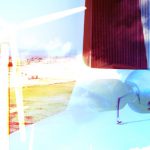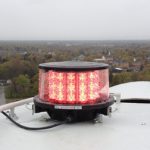Formerly known as Catch the Wind, Ltd., BlueScout Technologies recently changed ownership and management with a new vision to bring its groundbreaking wind measurement technology to market.
“Our name, BlueScout, is about the future,” said Jo Major, President and CEO of BlueScout. “We are using this rebranding to show our customers, investors, and partners our commitment to helping turbines reliably produce cleaner, renewable energy. We intend to use our technologies and skills to help our customers understand and manage their wind resources more effectively.”
The BlueScout OCS-210 is a next generation turbine control system designed for utility-scale wind turbines. By placing the system on top of the nacelle, the optical unit measures wind speed and direction in the approaching inflow and can employ predictive control architectures to increase energy production and reduce the harmful effects of wind turbulence on wind turbines.
The OWS-150 is a lightweight, portable, all-weather wind assessment tool that can be used up to 300 meters above the ground for wind prospecting, wind resource assessment and turbine performance assessment. This unit is designed to provide engineering analysis data on the same rugged fiber optic platform as the OCS.
“What’s happening now is the industry uses a conventional anemometer positioned behind the rotor,” Major said. “And because there is so much turbulence, it is less representative of the actual wind resource and it limits the quality of data that can be measured and used for control. Everyone in the industry acknowledges that anemometers mounted behind the rotor have a lot of problems. They’ve spent years and years working to control wind turbines with that data, but in the end analysis, the performance of the turbine is limited by the quality of the data coming in. What we do, in a sense, is very focused and elegant. We measure the wind before it hits the turbine and base the control of the turbine on the unperturbed air that is going to strike. There are a lot of valuable things we can do by measuring the wind in front of a turbine.”
By using this pre-strike wind turbine data, BlueScout’s optical control system allows for precise control that generates more power and cleaner operation with less wear and noise.
“There are a lot of economic benefits in knowing the characteristics of the wind before it hits the turbine,” he said. “There is a lot of focus in the industry on dynamically adjusting pitch for optimal performance. Currently, after the wind hits the blades they detect heavy wind either through deflection of the blades or increased torque on the generator and then the blades change pitch. We know where the wind is going and what the wind characteristics are going to be three, four or five seconds before it hits the wind turbine so controls can adjust the blade to the proper pitch for the wind that will be hitting the blades, as opposed to reacting to what has already happened. If you adjust after the fact, it is based upon the assumption that the wind is going to be the same after it hits as when it hit. Our approach is much cleaner. We simply say, ‘well, the wind is going to increase in velocity by 20 percent so we need to proactively change our pitch. ’ ”
“The wind moves on the order of 10 meters per second and our system can see the wind 50 to 100 to 150 meters out in front of the turbine, so you are looking at us being able to tell the turbine what the wind velocity will be in five seconds and in 10 seconds,” he said. “The blades can adjust their pitch rapidly, so there is plenty of warning for these pitch control systems to adapt.”
With the increased acceptance of LIDAR in the industry to measure wind velocity with optical beams, the BlueScout system should be familiar to wind industry. The BlueScout OCS units have an improved telescope to capture more light, a better heating system to prevent icing, and significantly improved signal processing. Major said “improving the system while lowering costs was a challenge for BlueScout engineers, but was necessary to bring the new OCS unit to market for a wider audience.”
“The vast majority of our work is on active turbines, so we’ll send out an installation team and they go up on the turbine and install the OCS,” Major said. “After operating the system for a while, we’ll flip the switch and integrate into the control of the turbine. We are big believers in being collaborative with our customers, so there is a complete sharing of data on how much power is being generated. We provide the owner wind speed, wind direction, power curves and other data that gives the wind farm owner a complete turbine control analysis.”
Major says BlueScout’s technology is in test with the National Renewable Energy Laboratory (NREL) and installed and collecting thousands of hours of data in the field with current customers. – S.M.
For more information, call 703-956-6554 or visit www.bluescout.com.








































